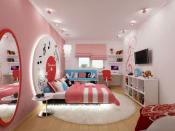Search
Login
Recommended
Private house lighting, design options, photos, schemes
Lighting in the house plays a very important role. Lighting affects the surrounding space, it determines how cozy the interior of the house may seem. Partial replacement of natural daylight with artificial, should be combined with the nature of each room, interact with its design and adapt to the needs of each room.
Content:
- Proper lighting, why is it so important?
- Hallway lighting
- Kitchen lighting
- Hall lighting
- Bedroom lighting
- Lighting in the nursery
- Bathroom lighting
- Lighting design video
Proper lighting in the house, why is it so important?
Each room needs a uniform, uniform lighting. Ceiling lamp gives diffused or reflective light. Wall lights perfectly replace the usual chandelier, the angle of incidence of light is easily adjustable for various purposes, but their number and installation locations require careful design.
In the rooms, a combination of several light sources, such as pendant lamps, floor and wall sconces, is possible, so they are convenient to use at different times of the day and illuminate depending on the purpose - reading books, drawing, going to sleep, lighting the entire room or part of it. Knowledge of the correct lighting design for each room can give the desired result in terms of functionality and aesthetics. Bright lighting in the office enhances concentration, while low light in the bedroom calms and prepares for bed.
Lighting in the kitchen and in the bathroom should not be blinding, and in the nursery it is necessary to take care of the access of artificial light over each area of \u200b\u200bthe room. About the basic lighting rules in each room, read below.
Hallway lighting
The hallway in our homes is often devoid of special attention, it is both an ordinary interior and low light. But it is precisely through this plain-looking corridor that our guests pass so often, and it is the entrance hall that first impresses the general view of the interior of the house. Most hallways do not have a natural light source, so the main task here is the appropriate choice and the correct location of the lamps.
When planning the lighting of a hallway, one should take into account its area, shape (square, rectangle or L-shaped corridor), whether there is natural light access, ceiling height, color of walls and furniture. Thus, artificial light can favorably emphasize individual places or illuminate the darkest corners of the hallway.
If your hallway is small and tall, the use of stray light is suitable, often the source of such light plays a decorative and functional role over the cabinet and mirror, but you should avoid pendant lights, as they visually reduce the room.
In the mirror corridor there will be enough overhead lighting, if the mirror is often used for applying makeup, it is worthwhile to additionally install wall lights on the sides.
Perfectly emphasizes the pattern on the wall suitable lamp.
Smooth bends not only illuminate the long corridor, but also complement the interior with originality.
Kitchen lighting
In the kitchen, the overall lighting should be uniform, but not dazzling. One general lighting in the center of the ceiling of the kitchen is not enough, it is important to also light up the cooking area. An approximate scheme of proper and convenient lighting:
There are several more ways to light a kitchen. The first way is reflected light. The luminous flux from the lamp is directed to the ceiling, from the ceiling the light gently bounces down.
The fashion for suspended ceilings brought a second way of lighting with halogen lamps. Built-in halogen lamps must be correctly distributed throughout the kitchen to illuminate all dark corners.
The third method is directional lighting, it is mainly used for lighting sinks, countertops, microwave ovens, creating convenience for the main tasks. To illuminate the directional light, halogen and fluorescent lamps are most often used, they can be located horizontally under the wall cabinets or stove.
The lighting of the kitchen-dining room is worthy of special attention, the distribution of light into several zones is important here. Cooking area and dining area. For example, a suspended ceiling with built-in halogen lighting can help you, in the area where the furniture and equipment for cooking dinner are located, the lighting should clearly separate the border, as if it were a wall. A beautiful lamp can be installed above the dining table.
Hall lighting
The hall in the house is often a living room. In this room they relax, receive guests and spend their free time. Since the hall, this is usually a fairly large area, bright lighting is required here, but adjustable.
You can use almost all types of lighting - ceiling, wall, table, with directional or reflected light.
When choosing fixtures, do not forget to choose them correctly taking into account the area and ceiling height. In large halls, luxurious chandeliers and wall sconces are not uncommon, for a smaller area, built-in halogen lamps and miniature wall lamps.
As with the kitchen, you can set up horizontal lighting above the bookcase and light up the shelves with photos.
Bedroom lighting
In the bedroom should not be set too bright light, it should be soft and warm. It does not need luxurious chandeliers and lamps, it will be enough spot lighting on the ceiling, several wall lights above the bed.
On the bedside tables by the bed, you can also put lamps that could very well replace the wall ones.
Decorative lighting performs different functions in this room, lighting on the floor level, in cabinets, on the walls - creates an atmosphere for sleep and relaxation.
Lighting in the nursery
Lighting in the nursery should clearly illuminate different areas. These are zones of play, workplace and rest. For a small children's room, two sources of artificial light will suffice, above the playroom and work area (where the child is doing homework), in addition to the evening hours of the day, you may need to illuminate the children's desk with a table lamp.
In general, it is better not to get carried away with table lamps and other protruding lamps - extra wires and lamps may not be safe for the child.
It is better to install fluorescent lamps or fluorescent lamps above each area of \u200b\u200bthe children's room. If you can not do without a table lamp, take care of its resistance to shock.
Bathroom lighting
When choosing lighting for the bathroom, as a rule, only functionality is used. Even the most original idea will not work if it is not practical.
For domestic convenience, lamps are installed in the bathroom on the sides of the mirror at eye level. It is best to use a lighting color close to natural sunlight. This will prevent the creation of a false color effect, which is important if makeup is often applied in the bathroom.
Consider the installation of lighting, which will serve mainly for decorative light. Miniature LED lamps built into the bathtub or furniture are great for this, they can be of different colors - blue calms, red adds energy, purple raises the mood.
The main lighting is provided by a chandelier on the ceiling, before it had only a practical function, now the market offers a wide variety of shapes and sizes, without violating the safety of bathroom fixtures.
Want to learn the right lighting design? An experienced designer will show you how bright masterpieces are created from gloomy rooms.





